
Senior Instructor, Department of Computer & Information Science (DCIS)

|
Vat Kam Hou 屈鑑濠 Senior Instructor, Department of Computer & Information Science (DCIS) |
10 Effective Classroom Management Techniques Every Faculty Member Should Know
|
Effective classroom management is much more than simply administering corrective measures when a student misbehaves; it’s about developing proactive ways to prevent problems from occurring in the first place while creating a positive learning environment.Establishing a climate for learning is one of the most challenging aspects of teaching, and one of the most difficult skills to master, even at the post-secondary level. For those new to the profession, failure to set the right tone will greatly hinder your effectiveness as a teacher. Indeed, even experienced faculty may sometimes feel frustrated by classroom management issues. Strategies that worked for years suddenly become ineffective in the face of some of the challenges today’s students bring with them to the classroom.Get 10 Effective Classroom Management Techniques Every Faculty Member Should KnowThis Faculty Focus special report features 10 proven approaches to classroom management from those on the front lines who’ve met the challenges head-on and developed creative responses that work with today’s students. The report will teach you practical ways to create favorable conditions for learning, including how to:
|
10 Effective Classroom Management Techniques Every Faculty Member Should Know will provide you with actionable strategies and no-nonsense solutions for creating a positive learning environment – whether you’re a seasoned educator or someone who’s just starting out. Good classroom management doesn’t just happen; you have to work at it. This collection of insightful classroom management articles is just the thing to help. If you feel like you’re spending more time disciplining than teaching, you’ll want to get your hands on 10 Effective Classroom Management Techniques Every Faculty Member Should Know, a Faculty Focus special report developed to give you the strategies you need to create a positive learning environment.
|
11 Strategies for Getting Students to Read What’s Assigned |
Getting students to take their reading assignments seriously is a constant battle. Even syllabus language just short of death threats, firmly stated admonitions regularly delivered in class, and the unannounced pop quiz slapped on desks when nobody answers questions about the reading don’t necessarily change student behaviors or attitudes. So what can be done?Despite the correlation between reading and course success, many students remain committed to trying to get by without doing the reading, or only doing it very superficially, or only doing it just prior to exam dates. In return, some exasperated instructors fall into the trap of using valuable class time to summarize key points of the readings. It’s not a new problem, and clearly we can’t simply bemoan the fact that students don’t read. Furthermore, doing what we’ve been doing — the threats, the endless quizzes, the chapter summaries — has failed to solve the problem. The better solution involves designing courses so that students can’t do well without reading, and creating assignments that require students to do more than just passively read. |
Featuring 11 articles from The Teaching Professor, this special report was created to give faculty new ways of attacking an age-old problem. Articles in the report include:
Whether your students struggle with the material or simply lack the motivation to read what’s assigned, this report will help ensure your students read and understand what’s assigned. |
Building Student Engagement: 15 Strategies for the College Classroom |
The more time students spend as active participants in learning activities, the more they learn. Research has proven this strong correlation again and again. But that doesn’t make it any easier to achieve. As an instructor, the challenge lies in not only lighting that fire of student engagement, but keeping the fire burning when student apathy and boredom creep into your classroom.If you’re looking for a few smart new strategies to add to your student engagement toolbox, this free report is just the ticket. |
Building Student Engagement: 15 Strategies for the College Classroom features proven tips for keeping students actively engaged in learning activities and offers ways to help you foster more meaningful interactions between students and faculty members, and among the students themselves. For example, in “Student Engagement: Trade-offs and Payoffs” E Shelley Reid, associate professor at George Mason University, talks about how to craft engagement-focused questions rather than knowledge questions, and explains her willingness to give up some control to her students. In “The Truly Participatory Seminar” Sarah M. Leupen and Edward H. Burtt, Jr., of Ohio Wesleyan University, outline their solution for ensuring all students in their upper-division seminar course participate in discussion at some level. In “Six Opportunities for Building Student Engagement” Chris Palmer of American University outlines student engagement strategies using the syllabus and those first few classes, as well as things you can do inside and outside the classroom to ensure positive interactions. In “Reminders for Improving Classroom Discussion” Roben Torosyan, associate director of the Center for Academic Excellence at Fairfield University, offers very specific advice on balancing student voices, reframing discussions, and probing below the surface of group discussions. And finally, in “Living for the Light Bulb” authors Aaron J. Nurick and David H. Carhart of Bentley College provide tips on setting the stage for that delightful time in class “when the student’s entire body says ‘Aha! Now I see it!’” Who wouldn’t like to see more light bulbs going on more often? Other articles in Building Student Engagement: 15 Strategies for the College Classroom include:
One of the most challenging tasks instructors face is keeping students engaged. Building Student Engagement: 15 Strategies for the College Classroom will help you meet that challenge while ensuring your classroom is a positive and productive learning environment. |
Effective Strategies for Improving College Teaching and Learning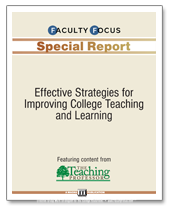
|
A love of course content and a willingness to convey that enthusiasm to students is a vital component to effective teaching, but you also need to make sure the methods used to convey that knowledge are up to the task.If you’re looking for some fresh approaches that will help make you a more effective teacher, you’ll want to download a copy of this free report. |
What we teach and how we teach it are inextricably linked. This special report features 11 articles pulled from the pages of The Teaching Professor to help you discover new ways to build connections between what you teach and how you teach it. The report offers tips on how to engage students, give feedback, create a climate for learning, and more. It also provides perspectives on how faculty should approach their development as teachers. Here’s a sample of the articles you will find in Effective Strategies for Improving College Teaching and Learning:
|
Journey of Joy: Teaching Tips for Reflection, Rejuvenation and Renewal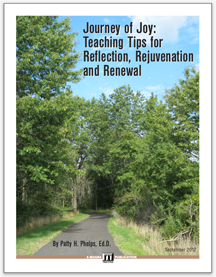
|
This ebook is about pursuing a joyful journey in college teaching. Part memoir and part advice for others, it is meant to encourage and inspire faculty who may have fallen out of love with teaching.The thrill is gone makes for a great blues song, but it also can be an accurate, albeit unfortunate, description of how experienced teachers may sometimes feel. Patty H. Phelps, EdD knows what it’s like. A few years ago, she says, her teaching life had reached what felt like a dead end. She would see articles in her local newspaper about faculty who were retiring and longed to be one of them. At the time, she was “going through the motions” and had definitely lost her joy of teaching. Today Phelps, a professor at the University of Central Arkansas and director of the Instructional Development Center on campus, has her joy back. In Journey of Joy: Teaching Tips for Reflection, Rejuvenation and Renewal she shares her experiences and offers advice to guide others to more joyful teaching. From building connections with students in new, unexpected ways to celebrating even minor victories, the ebook is loaded with practical tips for keeping your teaching fresh and invigorated. She writes: “We often hear the advice of ‘focus on the students.’ But, what exactly does this mean? I have found that it involves first getting the focus off self. However, it also entails giving of myself—my creative energies, my thought processes, my time and attention, and my expertise. I am pleased to report that my teaching joy has been restored.” |
This 32-page ebook is divided into 21 sections, each with its own set of tips for getting out or staying out of a teaching rut. The sections include:
As a student of teaching for 35 years, Phelps offers her personal perspectives as a means to help others find joy along the way, too. For the past three years she has led a standing-room-only plenary session on joy in teaching at the annual Teaching Professor Conference, inspiring her to create this written work to share with an even larger audience. |
Philosophy of Teaching Statements: Examples and Tips on How to Write a Teaching Philosophy Statement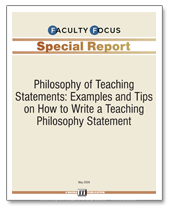
|
Traditionally part of the teaching portfolio in the tenure review process, an increasing number of colleges now require a philosophy of teaching statement from job applicants as well. For beginning instructors, putting their teaching philosophy into words is particularly challenging. For one thing they aren’t even sure they have a philosophy yet. Then there’s the added pressure of writing one that’s good enough to help them land their first teaching job.For most educators, writing a philosophy of teaching statement is a daunting, even unpleasant, task. Sure they can motivate the most lackadaisical of students, juggle a seemingly endless list of responsibilities, make theory and applications of gas chromatography come alive for students, all the while finding time to offer a few words of encouragement to a homesick freshman, but when it comes to articulating their teaching philosophy … suddenly they’re unsure where to even start. This Faculty Focus special report is designed to take the mystery out of writing teaching philosophy statements, and includes both samples and how-to articles written by educators from various disciplines and at various stages of their professional careers. When you download Philosophy of Teaching Statements: Examples and Tips on How to Write a Teaching Philosophy Statement, you will find inspiration and advice from articles like these:
|
Philosophy of teaching statements come in many styles and formats. And, as contributor Adam Chapnick writes, “There is no style that suits everyone, but there is almost certainly one that will make you more comfortable. And while there is no measurable way to know when you have got it ‘right,’ in my experience, you will know it when you see it!” This report will get you started. Philosophy of Teaching Statements: Examples and Tips on How to Write a Teaching Philosophy Statement is the perfect resource whether you’re writing your first statement or looking to revisit the one you penned years ago. |
Strategies for Teaching Large Classes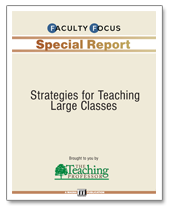
|
Large classes create enormous challenges for the faculty who teach them. From reducing anonymity to incorporating active learning activities, there’s a reason why large classes are considered the most difficult to teach … so much of what we know about effective instruction is all that much more difficult with a large class. If teaching large classes is a part of your life, you’ll want to download our new Special Report: Strategies for Teaching Large Classes.Sometimes you look out from the podium at the sea of faces looking back at you, and you wonder: Is this a class or a rock concert? Most educators would agree that their ideal teaching environment would be (to carry the musical theme a little further) the equivalent of an intimate, acoustic, coffee-shop performance. But instead, they often get… Woodstock. |
This 20-page report, Strategies for Teaching Large Classes, is yours FREE!Full of insights, ideas and best practices for the classroom, this must-have report features a dozen articles from our editorial staff and educators at leading colleges and universities nationwide. Here’s just a small sampling of the articles you’ll find in the Report…
You’ll discover new ways to make large classes meaningful for students, get ideas for creating a richer learning experience, and see how you can restore some sanity to your workload. |
Teaching Mistakes from the College Classroom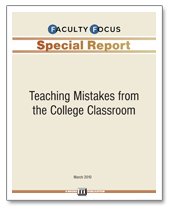
|
Think back to your first few years of teaching. If you’re like most educators, you probably made your share of mistakes. Maybe you were too strict … or not strict enough. Perhaps you were so absorbed delivering your course content that you didn’t realize half the class was completely lost. Or maybe you made assumptions about your students that later proved to be false. You’re not alone.Teaching Mistakes from the College Classroom features 15 reflective essays from instructors who were generous enough to share their early-career missteps in hopes that others can learn from their mistakes. |
When Faculty Focus put out a call for articles for this special report on teaching mistakes, we really didn’t know what to expect. Would faculty be willing to share their mistakes for all to see? Would the articles all talk about the same common mistakes, or would the range of mistakes discussed truly reflect the complexities of teaching today? We were delighted at the response, not only in terms of the number of instructors willing to share their stories with our readers, but by the variety of mistakes and lessons learned. For example, in “You Like Me, You Really Like Me. When Kindness Becomes a Weakness,” Jolene Cunningham writes of her discovery that doing everything you can for your students is not always the best policy. In “If I Tell Them, They Will Learn,” Nancy Doiron-Maillet writes about her realization that it’s not enough to provide information to students if they don’t have opportunities to then apply what you are trying to teach them. Other articles in Teaching Mistakes from the College Classroom include:
|
Tips for Encouraging Student Participation in Classroom Discussions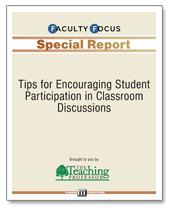
|
Motivating students to actively participate in class is a challenge even for the most experienced educators. The words “excruciating,” “agonizing,” and “mentally draining” likely come to mind. A lot of students seem to assume that as long as the assigned work is completed on time, test scores are good, and attendance is satisfactory, they shouldn’t be forced to participate.If you’re looking for proven strategies to help stimulate more active learning, you’ll want to download this FREE special report Tips for Encouraging Student Participation in Classroom Discussions. |
As proof of just how important classroom participation is to the learning process … and just hard it is to get students to participate … consider that most professors now include participation as part of the overall course grade. If they didn’t, few students would participate. And yet, despite the incentives to participate, research indicates that only about 25 percent of students in a course actively volunteer answers and contribute on a regular basis. Of course every class has a couple overparticipators who are eager to volunteer every answer (sometimes to the point of dominating the discussion, which creates its own problems for educators and fellow students alike) but it seems that a good number of students would rather listen, observe, or perhaps daydream rather than engage in the class discussion. Whether they’re shy, unprepared,or simply reluctant to share their thoughts and opinions, getting students to participate is a constant struggle. This special report features 11 articles that highlight effective strategies and tricks for establishing the expectation of participation, facilitating meaningful discussion, using questions appropriately, and creating a supportive learning environment. Articles you will find in this report include:
|
Go to: Dr. Vat's FST Homepage | Recommended Items (Page 0 |1 | 2 | 3 | 4 | 5 | 7 | 8 | 9)
Kam Hou Vat, PhD
Faculty of Science and Technology
University of Macau
Av. Padre Tomás Pereira, Taipa,
Macau, China
Room: N327C
Telephone: (Office) (853) 8397-4379, (Mobile) (853) 66501747
Fax: (Office) (853) 28838314 or (Home) (853) 28832731
Email: fstkhv
Personal Homepage: http://www.fst.umac.mo/en/staff/fstkhv.html
Downloadable: CV | Short Profile
Visitor Counter: